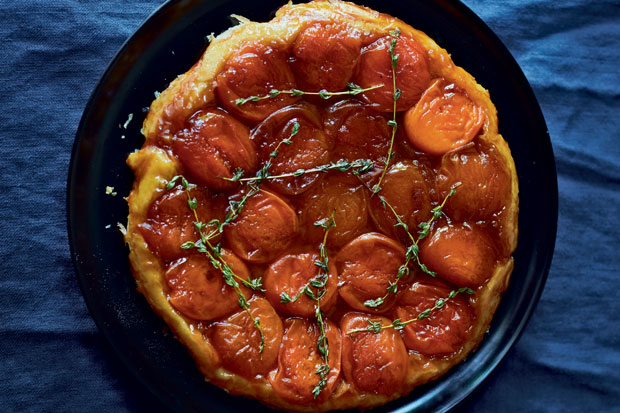Recipe
February 25, 2020
Apricot Tarte Tatin

Try this Apricot Tarte Tatin recipe from the new cookbook, Dinner in French.
 Using apricots instead of apples in a tarte Tatin transforms an inherently autumnal dessert into the very essence of summer. To keep things on the simpler side (relative to Tatin), I use purchased puff pastry here instead of making my own crust. I love the buttery, crunchy bits that shatter when you bite down, contrasting with the honeyed fruit. A few sprigs of fresh thyme add a lovely herbal perfume to the apricots, but if you don’t have them, you can leave them out or substitute lemon zest. This tart really benefits from something creamy served alongside. A bit of whipped cream or crème fraîche, or ice cream, will melt and mingle with the caramel, creating a rich and lovely sauce.
Using apricots instead of apples in a tarte Tatin transforms an inherently autumnal dessert into the very essence of summer. To keep things on the simpler side (relative to Tatin), I use purchased puff pastry here instead of making my own crust. I love the buttery, crunchy bits that shatter when you bite down, contrasting with the honeyed fruit. A few sprigs of fresh thyme add a lovely herbal perfume to the apricots, but if you don’t have them, you can leave them out or substitute lemon zest. This tart really benefits from something creamy served alongside. A bit of whipped cream or crème fraîche, or ice cream, will melt and mingle with the caramel, creating a rich and lovely sauce.
Directions
Yield: Serves 8
Thinking Ahead
Caramel: You can make the caramel up to six hours ahead; just leave it in the skillet. It will harden, but that’s okay — just heat it up on the stove until it melts.
Pastry: You can roll the pastry out up to six hours ahead; store it on a cookie sheet in the fridge until you’re ready to use it.
- Heat the oven to 425°F.
- In a 9-inch ovenproof skillet, combine ¼ cup water with the sugar, honey and salt. Bring the mixture to a boil; then reduce the heat and simmer, swirling the pan occasionally, until the sugar is caramelized and is the deep amber-brown color of an Irish setter, 4 to 8 minutes.
- Remove the skillet from the heat and whisk in the butter (the caramel may bubble up and splatter, so stand back). Then stir in the thyme sprigs. Let the mixture sit while you prepare the puff pastry.
- On a lightly floured surface, roll the pastry to form an 11-inch round about ⅛-inch thick, trimming it if necessary (it may have started out as a rectangle). Arrange the apricots, cut-side up, in the skillet atop the caramel, placing them as close together as possible. Drape the pastry over the apricots and then tuck the edges of the pastry into the skillet. Prick the pastry all over with the tip of a knife.
- Place the skillet on a rimmed baking sheet (to catch any overflowing filling), and bake until the pastry is browned and puffed, 30 to 35 minutes. Remove the skillet from the oven and let the tart cool slightly. Then run a butter knife or an offset spatula around the outer edge of the pastry to unstick it from the pan. Carefully flip the tart onto a serving platter, replacing any apricots that stuck to the pan. Note that the tart will come out most easily if it’s still a bit hot when you flip it.
- Serve the tart warm or at room temperature (within 6 hours of baking), drizzled with the caramel from the skillet, and topped with crème fraîche, whipped cream or ice cream if you like.
Excerpted from Dinner in French: My Recipes by Way of France by Melissa Clark. Copyright © 2020 by Melissa Clark. Published in the United States by Clarkson Potter/Publishers, an imprint of the Crown Publishing Group, a division of Penguin Random House LLC, New York. Reproduced by arrangement with the Publisher. All rights reserved.

